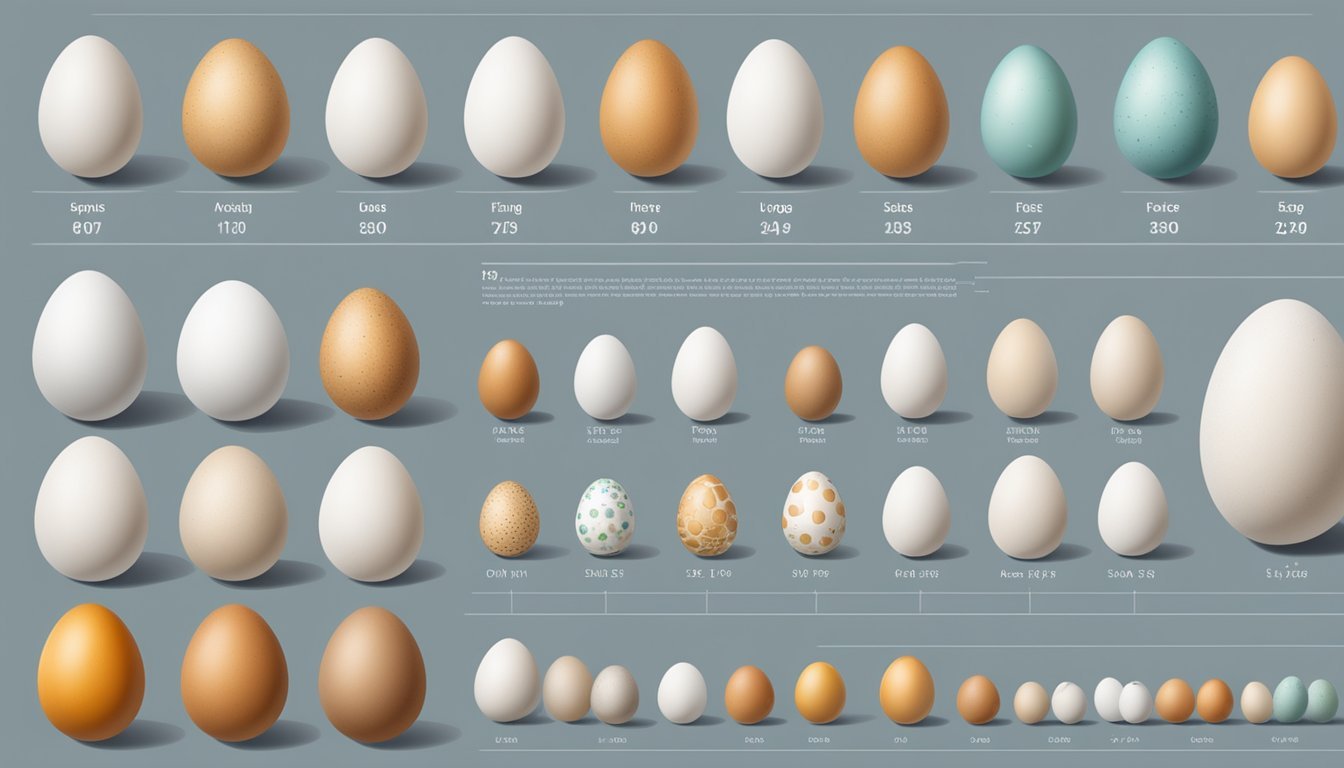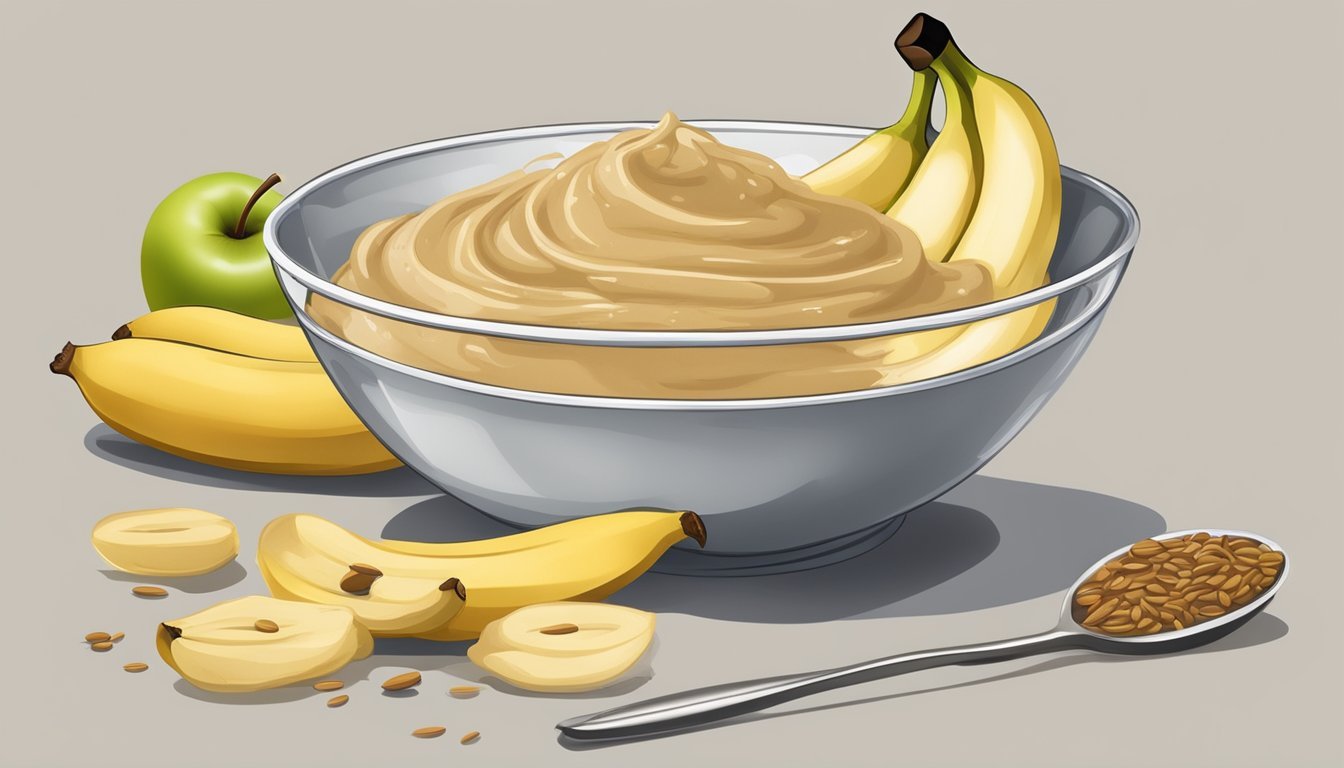Egg Substitution Chart
Your Guide to Egg-Free Baking Alternatives
Discover > Healthy Living Through Food > Egg Substitution Chart: Your Guide to Egg-Free Baking Alternatives
In the realm of vegan baking, mastering egg replacements like the flax egg is key. This versatile vegan egg substitute, created by combining ground flaxseed with water, mimics the binding properties of eggs, enhancing both flavor and texture in the finished product. Whether adjusting the egg size or experimenting with your favorite egg substitute, the world of egg-free cakes (how long do cakes last?) opens up new possibilities, turning dietary preferences into delightful culinary creations.
There is a variety of egg substitution options available for those looking to avoid eggs in their cooking and baking endeavors. These alternatives range from fruit purees, such as applesauce and banana, to dairy products like yogurt or buttermilk, and even include commercial egg replacers. Each substitute offers unique characteristics that can affect the texture, flavor, and structural integrity of the final product.
Understanding the properties of each egg substitute is essential for selecting the appropriate option for a given recipe. For instance, while a flaxseed meal mixed with water might work well as a binder in a dense and chewy cookie, it may not provide the right texture for a delicate and airy cake. Thus, an egg substitution chart can serve as a handy reference to guide cooks and bakers in making the right choice to achieve their desired culinary outcomes.
Understanding Egg Sizes and Conversions
When exploring cake recipes, understanding how to substitute different egg sizes becomes crucial for ensuring the intended outcome. Precise measurements are key, and this holds when dealing with common ingredients. Whether you're reaching for eggs from your local grocery store or a specialty health food store, having a grasp of egg size equivalents is essential.
Consider incorporating alternatives like Ener-G egg replacer, which can be found in health food stores and some grocery stores, offering a convenient solution for substitutions in recipes. This knowledge becomes particularly valuable when venturing beyond the typical recipe, allowing you to add your unique flavor to recipes without compromising on the final result.
Egg Sizing and Equivalents
Eggs come in various sizes, with large eggs being the standard called for in most recipes. The table below lists the typical weights and volumes for each egg size category:
Jumbo:
Weight Per Egg: 2.5 oz
Volume Per Egg: 3 tablespoons
Extra Large:
Weight Per Egg: 2.25 oz
Volume Per Egg: 4 tablespoons
Large:
Weight Per Egg: 2 oz
Volume Per Egg: 3.5 tablespoons
Medium:
Weight Per Egg: 1.75 oz
Volume Per Egg: 3 tablespoons
Small:
Weight Per Egg: 1.5 oz
Volume Per Egg: 2.5 tablespoons
When a recipe calls for a large egg but another size is all that's available, it becomes crucial to adjust the amount used accordingly. Generally, when substituting sizes, one can use the following equivalents:
1 large egg = 1 jumbo egg
1 large egg = 1 medium egg plus 1 tablespoon
1 large egg = 2 small eggs
Measurement Conversions
Quantitative precision in baking is a necessity. For egg conversions by volume or weight, use these measurements:
1 large egg is generally considered equivalent to 3.5 tablespoons of liquid egg, or approximately 50 grams by weight.
To substitute larger or smaller eggs by weight, one can follow these guidelines:
2 oz (56 grams) for a large egg
2.5 oz (70 grams) for a jumbo egg
1.75 oz (49 grams) for a medium egg
1.5 oz (42 grams) for a small egg
Substituting whole eggs with cups in recipes can be necessary when using bulk ingredients or liquid egg products. For cups:
1/4 cup of egg product is roughly equivalent to 1 large egg.
If partial cups are needed, every tablespoon counts as approximately 1/8 cup.
Using these standards will help foster consistency and reliability in cooking and baking, even when egg sizes on hand differ from those listed in a recipe.
Essential Egg Substitutes and Their Properties
Egg substitutes are diverse and can be primarily categorized into fruit-based, dairy, and non-dairy alternatives, as well as seeds (how long do seeds last?) and nuts (how long do nuts last?). Understanding their properties is crucial for effective use in various recipes.
Fruits as Substitutes
Fruits like bananas and applesauce serve as excellent egg substitutes in baking due to their moisture content and natural sweetness. Here's how they compare:
Banana: (how long do bananas last?) One medium mashed banana can replace one egg, which introduces a mild banana flavor and acts as a binder.
Applesauce: A quarter cup of applesauce can substitute for one egg, offering a slightly sweet taste and contributing to the moisture of the dish without heavy flavors.
Dairy and Non-Dairy Alternatives
Both dairy and non-dairy substitutes add a creamy texture that's beneficial in many recipes:
Plain Yogurt: Utilize a quarter cup of plain yogurt to replace one egg, adding moisture and a slight tanginess to the dish.
Buttermilk: A quarter cup of buttermilk can act as a substitute, introducing acidity that can help activate baking soda (how long does baking soda last?) for rise.
Silken Tofu: A quarter cup of puréed silken tofu (how long does tofu last?) can stand in for one egg, imparting minimal flavor while adding protein and moisture.
Seeds and Nuts
Seeds and nuts can replace eggs in recipes while also providing additional nutritional benefits:
Flaxseeds or Chia Seeds (how long do chia seeds last?)One tablespoon of ground flaxseeds (how long do flaxseeds last?) or chia seeds mixed with three tablespoons of water, left to rest until gelatinous, can substitute for one egg.
Almond Butter: Three tablespoons of almond butter (how long does almond butter last?) can replace one egg, adding a nutty flavor and dense texture.
Aquafaba: The liquid from canned chickpeas (how long do canned chickpeas last?), known as aquafaba, whips up like egg whites. Three tablespoons of aquafaba can be used in place of one egg for binding and in recipes that require egg whites, like meringues.
Egg Substitution for Common Baked Goods
When baking cakes, cupcakes, cookies, and brownies, it's important to choose the right egg substitute to maintain the desired texture and structure. Each alternative offers different properties, such as leavening, moisture, and tenderness, affecting the final product.
Cakes and Cupcakes
For cakes and cupcakes that require a light and airy texture, substitutes that provide leavening are essential. Here is a common substitute with its proportions:
Applesauce: Use 1/4 cup unsweetened applesauce to replace 1 egg. Applesauce adds moisture and creates a tender crumb.
Baking recipes may call for more than one egg for better rise and structure; in such cases, combining different substitutes can achieve comparable results.
Cookies and Brownies
Cookies and brownies benefit from substitutes that enhance moisture and density. Suitable substitutes include:
Mashed Banana: Use 1/2 of a mashed ripe banana for each egg to contribute to the chewy texture of brownies and cookies.
Flax or Chia Seeds: Mix 1 tablespoon ground flax or chia seeds with 3 tablespoons water, and let sit until thickened. This works well in chewy baking recipes.
Different recipes may require specific adjustments, so one should consider the role eggs play in the original recipe when selecting a substitute.
Alternative Ingredients for Specific Egg Functions
When eggs are not an option, several alternative ingredients can adeptly fulfill the roles that eggs traditionally play in cooking and baking. These roles include binding ingredients together, leavening baked goods, adding moisture and richness, and contributing to color and flavor.
Binding
In recipes where eggs are used as a binder to hold ingredients together, chia seeds and flax seeds can be effective substitutes. They create a gel-like substance when mixed with water that helps give structure to various dishes.
Chia Seeds: Mix 1 tablespoon of chia seeds with 3 tablespoons of water and let it sit for 5 minutes to replace one egg.
Flax Seed: Combine 1 tablespoon of ground flax seed with 3 tablespoons of water, and let it rest until it becomes gelatinous.
Leavening
When the goal is to make baked goods rise, baking soda combined with vinegar can serve as a leavening agent to replace eggs.
Baking Soda and Vinegar: Use 1 teaspoon of baking soda mixed with 1 tablespoon of vinegar to substitute one egg.
Moisture and Richness
To add moisture and richness to baked goods, egg alternatives that can effectively mimic this aspect include arrowroot powder (how long does arrowroot powder last?), cornstarch (how long does cornstarch last?), and agar-agar. These can enhance the texture and density of the final product.
Arrowroot Powder: Use 2 tablespoons of arrowroot powder mixed with 3 tablespoons of water to replace one egg.
Cornstarch: Similar to arrowroot, mix 2 tablespoons of cornstarch with 3 tablespoons of water.
Agar-Agar: Dissolve 1 tablespoon of agar-agar in 1 tablespoon of water for one egg's worth of moisture.
Color and Flavor
While eggs contribute to the golden color and savory flavor of many dishes, other ingredients can impart similar qualities. Soy lecithin adds a creaminess and slight sheen, while gelatin (not suitable for vegetarians) provides a glossy appearance and can improve the texture of desserts and pastries.
Soy Lecithin: Adding a small amount (about 1 tablespoon) gives a consistent flavor and color to baked goods.
Gelatin: Use one packet of gelatin dissolved in a small amount of water to substitute one egg for color and sheen.
Each alternative ingredient offers unique properties that can replace the specific functions of eggs in culinary applications. Their usage is dependable on the desired outcome of the recipe and dietary preferences.
Adapting Recipes for Dietary Needs
When modifying recipes to cater to dietary restrictions, it's crucial to select appropriate egg substitutes that align with specific needs without compromising the quality and texture of the final dish.
Vegan and Plant-Based Options
For those following a vegan or plant-based diet, eggs can be replaced with several alternatives. Flaxseed or chia seeds are common substitutes; when ground and mixed with water, they form a gel-like consistency, mimicking the binding properties of eggs. To replace one egg, simply mix one tablespoon of ground flaxseed or chia seeds with three tablespoons of water and let it sit until it thickens. Another option is tofu, particularly silken tofu, which is blended until smooth and used in a 1/4 cup measure per egg, offering moisture and binding in baking.
Commercial egg replacers are also available, typically made from potato starch (how long does potato starch last?), tapioca starch (how long does tapioca starch last?), and leavening agents. These products are specifically formulated to act like eggs in recipes, especially in baking, making them a hassle-free option for those avoiding animal products.
1 egg:
Vegan Substitute: Flaxseed/chia
Quantity: 1 tbsp + 3 tbsp water
1 egg:
Vegan Substitute: Silken tofu
Quantity: 1/4 cup blended
1 egg:
Vegan Substitute: Commercial replacer
Quantity: As specified on the package
Allergy-Friendly Choices
Allergies to eggs affect many individuals, necessitating reliable substitutes in cooking and baking. Applesauce is a common allergen-free alternative, providing moisture to baked goods; use 1/4 cup of unsweetened applesauce to replace one egg. Alternatively, mashed banana also works well for adding moisture and binding, with the added advantage of contributing natural sweetness. A common measurement is half a banana mashed to substitute for one egg.
Commercial egg replacers suited for those with allergies often exclude common allergens such as gluten, dairy, and of course, eggs. They are designed to provide similar results to eggs in recipes and are used according to the package instructions.
1 egg:
Allergy-Friendly Substitute: Applesauce
Quantity: 1/4 cup
1 egg:
Allergy-Friendly Substitute: Mashed banana
Quantity: 1/2 banana mashed
1 egg:
Allergy-Friendly Substitute: Commercial replacer
Quantity: As specified on the package
These alternatives ensure that individuals with vegan dietary preferences or egg allergies can enjoy a wide range of recipes without compromising on taste or texture.
Practical Egg Substitution Guide
When it comes to replacing eggs in recipes, understanding the various substitutes and their corresponding quantities is crucial for maintaining consistency and achieving the desired result.
Substitution Chart
Applesauce (unsweetened):
Quantity: 1/4 cup
Best Used for: Baking moist cakes and muffins
Mashed Banana:
Quantity: 1/4 cup
Best Used for: Sweet breads and pancakes
Ground Flaxseed or Chia Seeds:
Quantity: 1 tbsp mixed with 3 tbsp water
Best Used for: Whole-egg binding and texture
Silken Tofu (blended):
Quantity: 1/4 cup
Best Used for: Dense, moist baked goods
Vinegar and Baking Soda:
Quantity: 1 tbsp vinegar + 1 tsp baking soda
Best Used for: Fluffy cakes and quick breads
Yogurt or Buttermilk:
Quantity: 1/4 cup
Best Used for: Muffins and spongy cakes
Liquid Egg Product:
Quantity: 1/4 cup
Best Used for: Omelets and scrambled "eggs"
Aquafaba (chickpea brine):
Quantity: 3 tbsp
Best Used for: Meringues and vegan baked goods
Recipe Development with Egg Alternatives
While creating recipes, it’s essential to determine which egg substitute will best complement the desired taste and texture. For instance, flaxseed provides a nutty flavor and can add an extra chewiness to baked goods, whereas applesauce brings moistness without altering flavor.
Those looking for a high-protein alternative that closely mimics eggs might opt for liquid egg products. Meanwhile, aquafaba works wonders in recipes that require eggs for their whipping and foam-forming abilities, like meringues. It's important to identify which properties of eggs—binding, leavening, or moistening—are needed in a recipe to pick the most effective substitute.
Downloadable Resources and Kitchen Tools
Preparing egg dishes such as frittatas, quiches, (What wine goes well with quiche?) and custards ((how long do custards last?)) requires precise measurements and suitable substitutes when whole eggs are not available. This section provides resources for download and outlines essential kitchen tools for accurate conversion.
Egg Substitution Downloads
For those looking to replace eggs in their recipes, a variety of downloadable charts are available. They offer alternatives for whole eggs, ensuring that dishes such as scrambled eggs and baked goods turn out perfectly. For instance:
Flaxseed Meal: Mix 1 tablespoon of flaxseed meal with 3 tablespoons of water to replace one egg.
Applesauce: Use 1/4 cup of unsweetened applesauce to replace one egg in sweet baked recipes.
These downloadable charts aid in maintaining the desired texture and flavor of the egg dishes, even without the use of whole eggs.
Conversion Tools and Equipment
Accurate kitchen conversion tools are indispensable when cooking recipes that originally call for whole eggs. Below is a list of tools to aid in these conversions:
Measuring Cups and Spoons: Essential for precise measurements of substitute ingredients.
Kitchen Scale: A digital scale can ensure accurate ingredient weights, especially for recipe scaling.
Mixing Bowls: Various sizes to accommodate the mixing of substitutes with other ingredients.
These tools help chefs and home cooks alike to adapt recipes to their needs, ensuring successful egg-based dishes every time.









